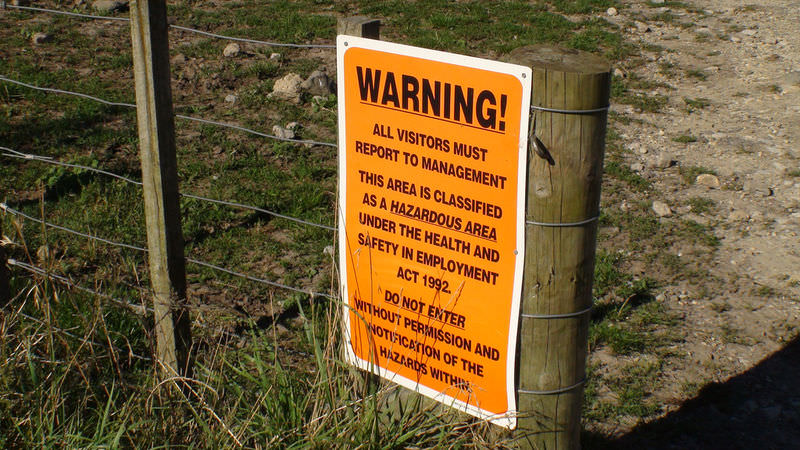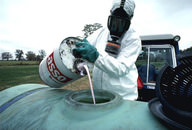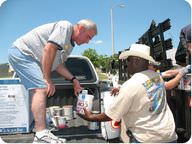21.8: Preventing Hazardous Waste Problems
- Page ID
- 6132
\( \newcommand{\vecs}[1]{\overset { \scriptstyle \rightharpoonup} {\mathbf{#1}} } \)
\( \newcommand{\vecd}[1]{\overset{-\!-\!\rightharpoonup}{\vphantom{a}\smash {#1}}} \)
\( \newcommand{\dsum}{\displaystyle\sum\limits} \)
\( \newcommand{\dint}{\displaystyle\int\limits} \)
\( \newcommand{\dlim}{\displaystyle\lim\limits} \)
\( \newcommand{\id}{\mathrm{id}}\) \( \newcommand{\Span}{\mathrm{span}}\)
( \newcommand{\kernel}{\mathrm{null}\,}\) \( \newcommand{\range}{\mathrm{range}\,}\)
\( \newcommand{\RealPart}{\mathrm{Re}}\) \( \newcommand{\ImaginaryPart}{\mathrm{Im}}\)
\( \newcommand{\Argument}{\mathrm{Arg}}\) \( \newcommand{\norm}[1]{\| #1 \|}\)
\( \newcommand{\inner}[2]{\langle #1, #2 \rangle}\)
\( \newcommand{\Span}{\mathrm{span}}\)
\( \newcommand{\id}{\mathrm{id}}\)
\( \newcommand{\Span}{\mathrm{span}}\)
\( \newcommand{\kernel}{\mathrm{null}\,}\)
\( \newcommand{\range}{\mathrm{range}\,}\)
\( \newcommand{\RealPart}{\mathrm{Re}}\)
\( \newcommand{\ImaginaryPart}{\mathrm{Im}}\)
\( \newcommand{\Argument}{\mathrm{Arg}}\)
\( \newcommand{\norm}[1]{\| #1 \|}\)
\( \newcommand{\inner}[2]{\langle #1, #2 \rangle}\)
\( \newcommand{\Span}{\mathrm{span}}\) \( \newcommand{\AA}{\unicode[.8,0]{x212B}}\)
\( \newcommand{\vectorA}[1]{\vec{#1}} % arrow\)
\( \newcommand{\vectorAt}[1]{\vec{\text{#1}}} % arrow\)
\( \newcommand{\vectorB}[1]{\overset { \scriptstyle \rightharpoonup} {\mathbf{#1}} } \)
\( \newcommand{\vectorC}[1]{\textbf{#1}} \)
\( \newcommand{\vectorD}[1]{\overrightarrow{#1}} \)
\( \newcommand{\vectorDt}[1]{\overrightarrow{\text{#1}}} \)
\( \newcommand{\vectE}[1]{\overset{-\!-\!\rightharpoonup}{\vphantom{a}\smash{\mathbf {#1}}}} \)
\( \newcommand{\vecs}[1]{\overset { \scriptstyle \rightharpoonup} {\mathbf{#1}} } \)
\( \newcommand{\vecd}[1]{\overset{-\!-\!\rightharpoonup}{\vphantom{a}\smash {#1}}} \)
\(\newcommand{\avec}{\mathbf a}\) \(\newcommand{\bvec}{\mathbf b}\) \(\newcommand{\cvec}{\mathbf c}\) \(\newcommand{\dvec}{\mathbf d}\) \(\newcommand{\dtil}{\widetilde{\mathbf d}}\) \(\newcommand{\evec}{\mathbf e}\) \(\newcommand{\fvec}{\mathbf f}\) \(\newcommand{\nvec}{\mathbf n}\) \(\newcommand{\pvec}{\mathbf p}\) \(\newcommand{\qvec}{\mathbf q}\) \(\newcommand{\svec}{\mathbf s}\) \(\newcommand{\tvec}{\mathbf t}\) \(\newcommand{\uvec}{\mathbf u}\) \(\newcommand{\vvec}{\mathbf v}\) \(\newcommand{\wvec}{\mathbf w}\) \(\newcommand{\xvec}{\mathbf x}\) \(\newcommand{\yvec}{\mathbf y}\) \(\newcommand{\zvec}{\mathbf z}\) \(\newcommand{\rvec}{\mathbf r}\) \(\newcommand{\mvec}{\mathbf m}\) \(\newcommand{\zerovec}{\mathbf 0}\) \(\newcommand{\onevec}{\mathbf 1}\) \(\newcommand{\real}{\mathbb R}\) \(\newcommand{\twovec}[2]{\left[\begin{array}{r}#1 \\ #2 \end{array}\right]}\) \(\newcommand{\ctwovec}[2]{\left[\begin{array}{c}#1 \\ #2 \end{array}\right]}\) \(\newcommand{\threevec}[3]{\left[\begin{array}{r}#1 \\ #2 \\ #3 \end{array}\right]}\) \(\newcommand{\cthreevec}[3]{\left[\begin{array}{c}#1 \\ #2 \\ #3 \end{array}\right]}\) \(\newcommand{\fourvec}[4]{\left[\begin{array}{r}#1 \\ #2 \\ #3 \\ #4 \end{array}\right]}\) \(\newcommand{\cfourvec}[4]{\left[\begin{array}{c}#1 \\ #2 \\ #3 \\ #4 \end{array}\right]}\) \(\newcommand{\fivevec}[5]{\left[\begin{array}{r}#1 \\ #2 \\ #3 \\ #4 \\ #5 \\ \end{array}\right]}\) \(\newcommand{\cfivevec}[5]{\left[\begin{array}{c}#1 \\ #2 \\ #3 \\ #4 \\ #5 \\ \end{array}\right]}\) \(\newcommand{\mattwo}[4]{\left[\begin{array}{rr}#1 \amp #2 \\ #3 \amp #4 \\ \end{array}\right]}\) \(\newcommand{\laspan}[1]{\text{Span}\{#1\}}\) \(\newcommand{\bcal}{\cal B}\) \(\newcommand{\ccal}{\cal C}\) \(\newcommand{\scal}{\cal S}\) \(\newcommand{\wcal}{\cal W}\) \(\newcommand{\ecal}{\cal E}\) \(\newcommand{\coords}[2]{\left\{#1\right\}_{#2}}\) \(\newcommand{\gray}[1]{\color{gray}{#1}}\) \(\newcommand{\lgray}[1]{\color{lightgray}{#1}}\) \(\newcommand{\rank}{\operatorname{rank}}\) \(\newcommand{\row}{\text{Row}}\) \(\newcommand{\col}{\text{Col}}\) \(\renewcommand{\row}{\text{Row}}\) \(\newcommand{\nul}{\text{Nul}}\) \(\newcommand{\var}{\text{Var}}\) \(\newcommand{\corr}{\text{corr}}\) \(\newcommand{\len}[1]{\left|#1\right|}\) \(\newcommand{\bbar}{\overline{\bvec}}\) \(\newcommand{\bhat}{\widehat{\bvec}}\) \(\newcommand{\bperp}{\bvec^\perp}\) \(\newcommand{\xhat}{\widehat{\xvec}}\) \(\newcommand{\vhat}{\widehat{\vvec}}\) \(\newcommand{\uhat}{\widehat{\uvec}}\) \(\newcommand{\what}{\widehat{\wvec}}\) \(\newcommand{\Sighat}{\widehat{\Sigma}}\) \(\newcommand{\lt}{<}\) \(\newcommand{\gt}{>}\) \(\newcommand{\amp}{&}\) \(\definecolor{fillinmathshade}{gray}{0.9}\)What should be done about hazardous waste sites?
Laws now protect lands from contamination. Many sites were damaged before those laws were passed. Cleaning up toxic wastes costs a lot of time and money. Sometimes the company that caused the damage no longer exists. Sometimes they cannot afford cleanup. Then it becomes the government's job to clean up the site. No other organization is big enough to be sure a cleanup happens.
The Superfund Act
Love Canal opened people’s eyes to toxic waste burial. They realized there must be other “Love Canals” all over the country. Thousands of contaminated sites were found. The Superfund Act was passed in 1980. The law required that money be set aside for cleanup of toxic waste sites. The law also required safer disposal of hazardous waste in the future.
Love Canal became a Superfund site in 1983. As a result, several measures were taken to secure the toxic wastes. The land was capped so that water could not reach the waste. Toxic material was cleaned from the nearby area. Contaminated soils were removed.
Controlling Hazardous Waste
The greatest source of hazardous waste is industry. Agriculture is another major source. Even households produce a lot of hazardous waste.
Hazardous Waste From Industry and Agriculture
Thanks to the lessons of Love Canal, the U.S. now has laws requiring the safe disposal of hazardous waste. Companies must ensure that hazardous waste is not allowed to enter the environment in dangerous amounts. They must also protect their workers from hazardous materials. For example, they must provide employees with the proper safety gear and training (Figure below).
This agricultural worker is wearing the proper safety gear to handle a chemical pesticide.
Household Hazardous Waste
Cleaning products, lawn chemicals, paints, batteries, motor oil—these are just some of the many hazardous materials that may be found in households. You might think that a household doesn’t produce enough hazardous waste to worry about. But all the waste from all the households adds up. A city of just 50,000 people might produce more than 40 tons of hazardous waste each year! Clearly, how households deal with hazardous waste matters.
What can your family do? Reduce, reuse, recycle, or properly dispose of the wastes.
- Reduce the amount of hazardous products you buy. For example, if you need only a quart of paint for a job, don’t buy a gallon.
- Use less hazardous products if you can. For example, clean windows with vinegar and water instead of toxic window cleaners.
- Reuse products if it’s safe to do so. For example, paint thinner that has been used to clean paint brushes can be strained and reused.
- Recycle whenever possible. For example, some service stations allow you to drop off used motor oil, car batteries, or tires for recycling.
- Always properly dispose of hazardous waste. For example, let liquid waste evaporate before placing the container in the trash.
Proper disposal depends on the waste. Many hazardous products have disposal guidelines on the label. That’s one reason why you should keep the products in their original containers. The labels also explain how to use the products safely. Follow the instructions to protect yourself and the environment. Most communities have centers for disposing of household hazardous waste (Figure below). Do you know how to dispose of hazardous waste in your community?
Avoid putting hazardous waste in the household trash. Instead, take it to a hazardous waste collection center.
Summary
- Government regulations, like the Superfund Act, hold companies accountable for the hazardous materials they produce.
- Reduce, reuse, recycle to lessen your production of toxic waste.
- Dispose of toxic wastes properly.
Review
- How do the Superfund Act and other government regulations prevent lands from being contaminated?
- What can you do to prevent or lessen the generation of hazardous wastes?
- How should you dispose of toxic wastes?




